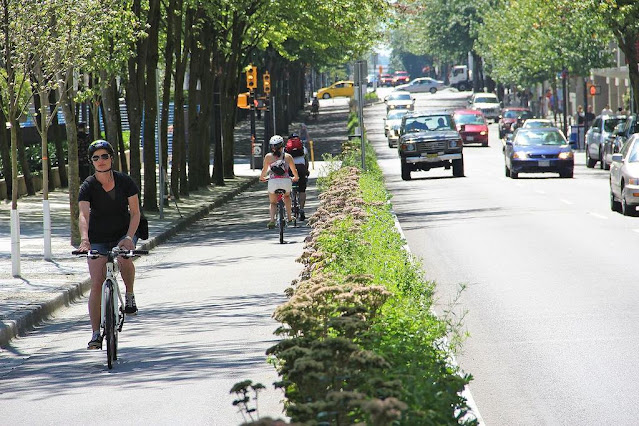Keith Kingbay did as much as anyone could have to keep the torch flickering during what Sheldon Brown has called “The Dark Ages” of American cycling. He was a racer who helped to develop what was, for a couple of decades, the only world-class racing or touring bike made, or even conceived, in the US: the Schwinn Paramount.
But perhaps more important, he was a strong advocate for cycling when there were still relatively few adult cyclists in the US. He helped to reorganize the all-but-moribund League of American Wheelmen into the League of American Cyclists. So, perhaps not surprisingly, he championed what we now call “bicycling infrastructure.”
I now recall reading his articles and a book he authored or co-authored in the early or mid-1970s, when I first became a dedicated cyclist. As I am remembering, he said something to the effect that getting community support for cycling events is not difficult because bicycles are “not controversial.”
He passed away three decades ago. I thought of him in light of an argument about a Brooklyn bike lane.
In recent years, bicycles have become, at least in the US, symbols of environmental awareness and sustainability or, if you are of a different social and political persuasion, everything that threatens the top-down, fossil fuel-consuming world as you’ve known it. In other words, it’s become a symbol of evolution or destruction.
While some individual religious people cycle for transportation or recreation, their organizations —especially if they are fundamentalist or otherwise conservative —aren’t exactly advocates for cyclists or cycling . On the surface, their hostility has to do with their alliances with right-wing politics. But if you probe deeper, you realize that the marriage of religious fundamentalism and political conservatism that veers into facism has to do with a shared interest in preserving patriarchal economic and social structures and what they perceive as “traditional” gender roles.
So, while the Satmar Chasidic Jews of Brooklyn may not have, or want, much participation in the techno-financial complex, they don’t want “scantily-clad” “sexy-ass hipster girls” rolling through their neighborhoods. That is why they (or their leaders at any rate) opposed Citibike, New York’s bike share program, and bike lanes.
Their opposition to the latter would have, only a few years ago, explained their delight in Judge Carolyn Walker-Diallo’s ruling to uphold Mayor Eric Adams’ decision to remove a protected bike lane on Bedford Avenue, one of the borough’s major thoroughfares, without community notification or the other normal processes required for a major transportation project. In essence, Judge Walker-Diallo said that bike lane removal or replacement is not a major transportation project.
But the Chasidic community’s—and the neighborhood’s —leaders were not pleased. Not because, as it turns out, Walker-Diallo contributed financially to the political campaign of a local bike lane opponent. Nor did it matter that the Department of Transportation under Adams, who is widely disliked in the community*, installed the lane.
Rather, their umbrage has to do with the fact that children were using the lane to ride their bikes to school. In fact, the suit against the lane’s removal (which ended with the judge’s decision) was initiated on behalf of one of those children. Peter Beadle, the lawyer representing him used the DOT’s own data showing that protected bike lanes reduced injuries by nearly half—to no avail.
He did, however, see a glimmer of hope. If changing from one type of bike lane to another doesn’t require community notice, he said, “then we need to change all non-protected lanes to protected lanes immediately because we know they make all road users safer.”
So, if bicycles themselves aren’t controversial, as Keith Kingbay wrote half a century ago, could he—or anyone else—have foreseen the controversies they could engender, let alone how they could flip political alliances?
*—I, too, am not a fan of the mayor, if for different reasons.

.jpg)


























